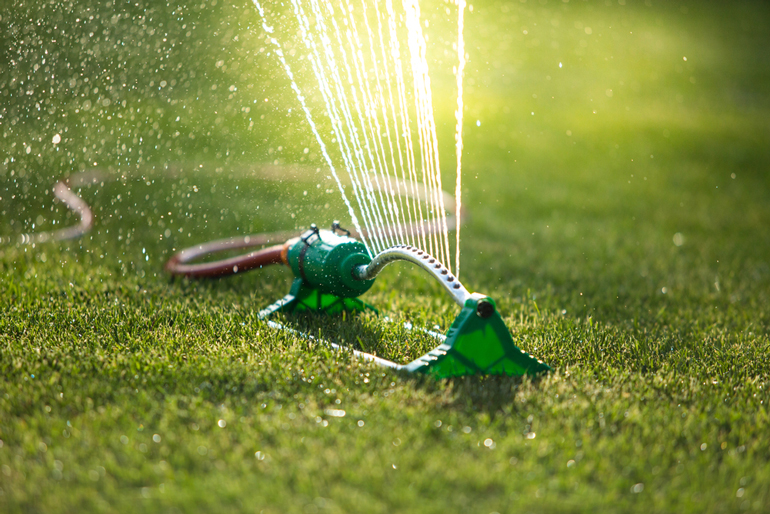Keeping your lawn green and healthy, especially during dry and hot weather, depends on how well you manage irrigation. These lawn irrigation tips will help you understand how to water your grass efficiently, guaranteeing your lawn stays vibrant while conserving water. A well-irrigated lawn not only looks good but also contributes to the overall health of your outdoor space.
Water Lightly but Frequently
Many homeowners believe that a deep, once-weekly watering is the best way to keep grass green. However, research shows that lighter, more frequent watering can be just as effective, if not better, in some situations.
For example, daily irrigation with about 0.1 inches of water can cool the turf during the hottest parts of the day and keep it hydrated. This method also reduces stress caused by heat and helps protect against diseases like Necrotic ring spots. For lawns facing extreme weather, frequent irrigation can be a game-changer.
Adjust Irrigation Based on Soil and Sun Exposure
Before you set your irrigation schedule, consider your lawn’s specific conditions. Shady areas and lawns with clay soil may require less water, while sandy soil and sunny spots dry out faster. Each section of your lawn may need different amounts of water depending on its exposure and soil type.
Customizing your watering plan for each area will prevent overwatering and under-watering, keeping your lawn balanced. Saylee Greer, LLC’s irrigation design services offer customized solutions for every type of lawn, making sure your irrigation system is tailored to your yard’s specific needs.
Water During the Early Morning
Timing is everything when it comes to irrigation. Early morning, before the heat of the day, is the ideal time to water your lawn. This allows water to soak into the soil before it evaporates under the midday sun.
By watering in the morning, your grass has the chance to absorb water efficiently without sitting too long and promoting fungal growth. If morning watering isn’t possible, late afternoon is the next best time, but avoid watering in the evening to prevent disease.
Consider Using an In-Ground Irrigation System
If maintaining a green lawn throughout the summer is important to you, an in-ground irrigation system could be a helpful tool. These systems distribute water evenly across your yard, allowing for more consistent hydration, especially in larger areas.
In-ground systems can also be automated, making sure your lawn gets the water it needs even when you’re away. They bring precise control over the amount and timing of water. This reduces waste and makes sure your lawn stays green. Installing flagstone patios along with an irrigation system helps protect areas of your lawn that see heavy foot traffic, combining functionality and aesthetics.
Watch for Watering Restrictions
Depending on where you live, your community may have restrictions on when and how much you can water your lawn, especially during periods of drought. It’s necessary to stay informed about any local watering restrictions and adjust your schedule accordingly.
If daily irrigation is not allowed, consider watering every second or third day with slightly larger amounts, approximately 0.25 inches. This can help your lawn stay hydrated while complying with local regulations.
Check for Lawn Diseases and Pests
Frequent irrigation can help reduce damage caused by certain lawn diseases and pests, such as European chafer grubs. Daily watering during peak heat can significantly decrease the survival rate of these pests. Light, frequent watering can also help mitigate the impact of common lawn diseases that thrive in hot, dry conditions.
If you’ve noticed pest damage in your lawn, integrating irrigation with commercial landscaping services may help by providing expert advice on both watering and pest control.
Keep Your Expectations Realistic
Not every lawn can or should be kept perfectly green during the summer. Some turf types, such as fescue and Kentucky bluegrass, naturally go dormant when the weather is too hot. If your lawn is prone to going dormant, it’s key to adjusting your expectations.
A dormant lawn will often recover once temperatures cool and regular rainfall returns. Understanding your lawn’s natural tendencies will help you create a realistic irrigation plan that aligns with your goals and local conditions.
Monitor Your Water Usage
While it’s needed to keep your lawn hydrated, water conservation should also be a priority. Overwatering not only wastes water but can also lead to shallow root systems and promote the growth of diseases. A smart approach is to monitor how much water your lawn is receiving, either through a rain gauge or by setting your irrigation system to precise levels.
Smart irrigation systems are becoming more popular, allowing you to control the timing and amount of water your lawn receives from your smartphone. These systems can adjust to weather conditions, further improving efficiency and helping to prevent overwatering during rainy periods.
We understand that every lawn has unique needs. Our design and irrigation services at Saylee Greer, LLC, will help you create the perfect plan for your yard. Whether it’s a customized irrigation system or expert advice on maintaining a green, healthy lawn, we’re here to assist.

